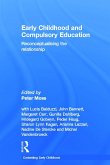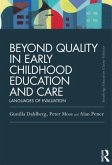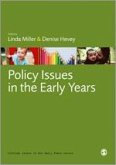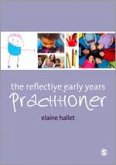Early Childhood Matters
Evidence from the Effective Pre-School and Primary Education Project
Herausgeber: Sylva, Kathy; Taggart, Brenda; Siraj-Blatchford, Iram; Sammons, Pam; Melhuish, Edward
Early Childhood Matters
Evidence from the Effective Pre-School and Primary Education Project
Herausgeber: Sylva, Kathy; Taggart, Brenda; Siraj-Blatchford, Iram; Sammons, Pam; Melhuish, Edward
- Gebundenes Buch
- Merkliste
- Auf die Merkliste
- Bewerten Bewerten
- Teilen
- Produkt teilen
- Produkterinnerung
- Produkterinnerung
This book documents the rapid development of the importance of early years education from the late 90s into this millennium, providing a unique contribution to the importance of pre-school.
Andere Kunden interessierten sich auch für
![Early Childhood and Compulsory Education Early Childhood and Compulsory Education]() Early Childhood and Compulsory Education196,99 €
Early Childhood and Compulsory Education196,99 €![Beyond Quality in Early Childhood Education and Care Beyond Quality in Early Childhood Education and Care]() Gunilla DahlbergBeyond Quality in Early Childhood Education and Care198,99 €
Gunilla DahlbergBeyond Quality in Early Childhood Education and Care198,99 €![Sustained Shared Thinking in the Early Years Sustained Shared Thinking in the Early Years]() Kathy BrodieSustained Shared Thinking in the Early Years252,99 €
Kathy BrodieSustained Shared Thinking in the Early Years252,99 €![Supporting Boys' Writing in the Early Years Supporting Boys' Writing in the Early Years]() Julie CigmanSupporting Boys' Writing in the Early Years198,99 €
Julie CigmanSupporting Boys' Writing in the Early Years198,99 €![Narrative Inquiry in Early Childhood and Elementary School Narrative Inquiry in Early Childhood and Elementary School]() Stephanie Sisk-HiltonNarrative Inquiry in Early Childhood and Elementary School198,99 €
Stephanie Sisk-HiltonNarrative Inquiry in Early Childhood and Elementary School198,99 €![Policy Issues in the Early Years Policy Issues in the Early Years]() Linda MillerPolicy Issues in the Early Years173,99 €
Linda MillerPolicy Issues in the Early Years173,99 €![The Reflective Early Years Practitioner The Reflective Early Years Practitioner]() Elaine HalletThe Reflective Early Years Practitioner152,99 €
Elaine HalletThe Reflective Early Years Practitioner152,99 €-
-
-
This book documents the rapid development of the importance of early years education from the late 90s into this millennium, providing a unique contribution to the importance of pre-school.
Hinweis: Dieser Artikel kann nur an eine deutsche Lieferadresse ausgeliefert werden.
Hinweis: Dieser Artikel kann nur an eine deutsche Lieferadresse ausgeliefert werden.
Produktdetails
- Produktdetails
- Verlag: Taylor & Francis
- Seitenzahl: 280
- Erscheinungstermin: 1. Februar 2010
- Englisch
- Abmessung: 234mm x 156mm x 18mm
- Gewicht: 572g
- ISBN-13: 9780415482424
- ISBN-10: 0415482429
- Artikelnr.: 29339216
- Herstellerkennzeichnung
- Libri GmbH
- Europaallee 1
- 36244 Bad Hersfeld
- gpsr@libri.de
- Verlag: Taylor & Francis
- Seitenzahl: 280
- Erscheinungstermin: 1. Februar 2010
- Englisch
- Abmessung: 234mm x 156mm x 18mm
- Gewicht: 572g
- ISBN-13: 9780415482424
- ISBN-10: 0415482429
- Artikelnr.: 29339216
- Herstellerkennzeichnung
- Libri GmbH
- Europaallee 1
- 36244 Bad Hersfeld
- gpsr@libri.de
Kathy Sylva is Professor of Educational Psychology, University of Oxford. Edward Melhuish is Professor of Human Development, Birkbeck College, University of London. Pam Sammons is Professor of Education, University of Oxford. Iram Siraj-Blatchford is Professor of Education, Institute of Education, University of London. Brenda Taggart is Senior Research Officer, Institute of Education, University of London.
Selected Contents: Chapter 1 Introduction: Why EPPE? Kathy Sylva and the
EPPE Team Chapter 2 The EPPE settings in the context of English pre-schools
Iram Siraj-Blatchford Chapter 3 The EPPE Research design: An educational
effectiveness focus Pam Sammons Chapter 4 Why children, parents and home
learning are important Edward Melhuish Chapter 5 Quality in Early Childhood
settings Kathy Sylva Chapter 6 Does pre-school make a difference?: Results
over the pre-school period (to aged 5) Pam Sammons Chapter 7 Do the
benefits of pre-school last? Investigating pupil outcomes to the end of Key
Stage 2 (aged 11) Pam Sammons Chapter 8 A focus on pedagogy: Case studies
of effective practice Iram Siraj-Blatchford Chapter 9 Vulnerable children:
Identifying children 'at risk' Brenda Taggart Chapter 10 A linked study:
Effective Pre-school Provision in Northern Ireland Edward Melhuish Chapter
11 Making a difference: How research can inform policy Brenda Taggart
Chapter 12 Re-thinking the evidence-base for Early Years policy and
practice Kathy Sylva Glossary of terms Appendix 1 How children were
assessed at different time points throughout the study Appendix 2 The Home
Learning Environment at different time points Appendix 3 The EPPE Technical
Papers Appendix 4 Social/behavioural dimensions at different time points
(items associated with dimensions) Appendix 5 The Multiple Disadvantage
Index Appendix 6 Results from analyses of pre-school effects compared with
those of family income and parents' employment status
EPPE Team Chapter 2 The EPPE settings in the context of English pre-schools
Iram Siraj-Blatchford Chapter 3 The EPPE Research design: An educational
effectiveness focus Pam Sammons Chapter 4 Why children, parents and home
learning are important Edward Melhuish Chapter 5 Quality in Early Childhood
settings Kathy Sylva Chapter 6 Does pre-school make a difference?: Results
over the pre-school period (to aged 5) Pam Sammons Chapter 7 Do the
benefits of pre-school last? Investigating pupil outcomes to the end of Key
Stage 2 (aged 11) Pam Sammons Chapter 8 A focus on pedagogy: Case studies
of effective practice Iram Siraj-Blatchford Chapter 9 Vulnerable children:
Identifying children 'at risk' Brenda Taggart Chapter 10 A linked study:
Effective Pre-school Provision in Northern Ireland Edward Melhuish Chapter
11 Making a difference: How research can inform policy Brenda Taggart
Chapter 12 Re-thinking the evidence-base for Early Years policy and
practice Kathy Sylva Glossary of terms Appendix 1 How children were
assessed at different time points throughout the study Appendix 2 The Home
Learning Environment at different time points Appendix 3 The EPPE Technical
Papers Appendix 4 Social/behavioural dimensions at different time points
(items associated with dimensions) Appendix 5 The Multiple Disadvantage
Index Appendix 6 Results from analyses of pre-school effects compared with
those of family income and parents' employment status
Selected Contents: Chapter 1 Introduction: Why EPPE? Kathy Sylva and the
EPPE Team Chapter 2 The EPPE settings in the context of English pre-schools
Iram Siraj-Blatchford Chapter 3 The EPPE Research design: An educational
effectiveness focus Pam Sammons Chapter 4 Why children, parents and home
learning are important Edward Melhuish Chapter 5 Quality in Early Childhood
settings Kathy Sylva Chapter 6 Does pre-school make a difference?: Results
over the pre-school period (to aged 5) Pam Sammons Chapter 7 Do the
benefits of pre-school last? Investigating pupil outcomes to the end of Key
Stage 2 (aged 11) Pam Sammons Chapter 8 A focus on pedagogy: Case studies
of effective practice Iram Siraj-Blatchford Chapter 9 Vulnerable children:
Identifying children 'at risk' Brenda Taggart Chapter 10 A linked study:
Effective Pre-school Provision in Northern Ireland Edward Melhuish Chapter
11 Making a difference: How research can inform policy Brenda Taggart
Chapter 12 Re-thinking the evidence-base for Early Years policy and
practice Kathy Sylva Glossary of terms Appendix 1 How children were
assessed at different time points throughout the study Appendix 2 The Home
Learning Environment at different time points Appendix 3 The EPPE Technical
Papers Appendix 4 Social/behavioural dimensions at different time points
(items associated with dimensions) Appendix 5 The Multiple Disadvantage
Index Appendix 6 Results from analyses of pre-school effects compared with
those of family income and parents' employment status
EPPE Team Chapter 2 The EPPE settings in the context of English pre-schools
Iram Siraj-Blatchford Chapter 3 The EPPE Research design: An educational
effectiveness focus Pam Sammons Chapter 4 Why children, parents and home
learning are important Edward Melhuish Chapter 5 Quality in Early Childhood
settings Kathy Sylva Chapter 6 Does pre-school make a difference?: Results
over the pre-school period (to aged 5) Pam Sammons Chapter 7 Do the
benefits of pre-school last? Investigating pupil outcomes to the end of Key
Stage 2 (aged 11) Pam Sammons Chapter 8 A focus on pedagogy: Case studies
of effective practice Iram Siraj-Blatchford Chapter 9 Vulnerable children:
Identifying children 'at risk' Brenda Taggart Chapter 10 A linked study:
Effective Pre-school Provision in Northern Ireland Edward Melhuish Chapter
11 Making a difference: How research can inform policy Brenda Taggart
Chapter 12 Re-thinking the evidence-base for Early Years policy and
practice Kathy Sylva Glossary of terms Appendix 1 How children were
assessed at different time points throughout the study Appendix 2 The Home
Learning Environment at different time points Appendix 3 The EPPE Technical
Papers Appendix 4 Social/behavioural dimensions at different time points
(items associated with dimensions) Appendix 5 The Multiple Disadvantage
Index Appendix 6 Results from analyses of pre-school effects compared with
those of family income and parents' employment status








